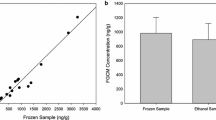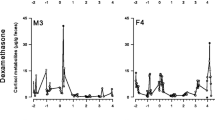Abstract
Since the non-invasive field endocrinology techniques were developed, several fecal preservation and extraction methods have been established for a variety of species. However, direct adaptation of methods from previous studies for use in crested macaques should be taken with caution. We conducted an experiment to assess the accuracy and stability of fecal estrogen metabolite (E1C) and glucocorticoid metabolite (GCM) concentrations in response to several preservation parameters: (1) time lag between sample collection and fecal preservation; (2) long-term storage of fecal samples in 80% methanol (MeOH) at ambient temperature; (3) different degrees of feces drying temperature using a conventional oven; and (4) different fecal preservation techniques (i.e., freeze-drying, oven-drying, and field-friendly extraction method) and extraction solvents (methanol, ethanol, and commercial alcohol). The study used fecal samples collected from crested macaques (Macaca nigra) living in the Tangkoko Reserve, North Sulawesi, Indonesia. Samples were assayed using validated E1C and GCM enzyme immunoassays. Concentrations of E1C and GCM in unprocessed feces stored at ambient temperature remained stable for up to 8 h of storage after which concentrations of both E1C and GCM changed significantly compared to controls extracted at time 0. Long-term storage in 80% MeOH at ambient temperature affected hormone concentrations significantly with concentrations of both E1C and GCM increasing after 6 and 4 months of storage, respectively. Drying fecal samples using a conventional oven at 50, 70, and 90 °C did not affect the E1C concentrations, but led to a significant decline for GCM concentrations in samples dried at 90 °C. Different fecal preservation techniques and extraction solvents provided similar results for both E1C and GCM concentrations. Our results confirm previous studies that prior to application of fecal hormone analysis in a new species, several preservation parameters should be evaluated for their effects on hormone metabolite stability. The results also provide several options for fecal preservation, extraction, and storage methods that can be selected depending on the condition of the field site and laboratory.




Similar content being viewed by others
References
Beehner JC, Whitten PL (2004) Modification of a field method for fecal steroid analysis in baboons. Physiol Behav 82:269–277
Bielohuby M, Popp S, Bidlingmaier M (2012) A guide for measurement of circulating metabolic hormones in rodents: pitfalls during the pre-analytical phase. Mol Metab 1:47–60
Ganswindt A, Palma R, Heistermann M, Borragan S, Hodges JK (2003) Non-invasive assessment of adrenocortical function in the male African elephant (Loxodonta africana) and its relation to musth. Gen Comp Endocrinol 134:156–166
Gholib (2011) Non-invasive hormone monitoring: faecal androgen and glucocorticoid in male crested macaques (Macaca nigra) in relation to seasonal and social factors. Thesis. Bogor Agricultural University
Goymann W (2012) On the use of non-invasive hormone research in uncontrolled, natural environments: the problem with sex, diet, metabolic rate and the individual. Methods Ecol Evol 3:757–765
Heistermann M, Hodges JK (1995) Endocrine monitoring of the ovarian cycle and pregnancy in the saddle-black tamarin (Saguinus fuscicollis) by measurement of steroid conjugate in urine. Am J Primatol 35:117–127
Heistermann M, Palme R, Ganswindt A (2006) Comparison of different enzyme immunoassays for assessment of adrenocortical activity in primates based on fecal analysis. Am J Primatol 68:257–273
Higham JP, Heistermann M, Saggau C, Agil M, Perwitasari-Farajallah D, Engelhardt A (2012) Sexual signaling in female crested macaques and the evolution of primate fertility signals. BMC Evol Biol 12:89–95
Hodges JK, Heistermann M (2011) Field endocrinology: monitoring hormonal changes in free-ranging primates. In: Setchell JM, Curtis DJ (eds) Field and laboratory methods in primatology: a practical guide, 2nd edn. Cambridge University Press, Cambridge, pp 353–370
Hunt KE, Wasser SK (2003) Effect of long-term preservation methods on fecal glucocorticoid concentrations of grizzly bear and African elephant. Physiol Biochem Zool 76:918–928
International Union for Conservation of Nature (IUCN) (2017) Crested Macaques (Macaca nigra). http://www.iucnredlist.org. Accessed 5 Jan 2017
Kalbitzer U, Heistermann M (2013) Long-term storage effects in steroid metabolite extracts from baboon (Papio sp.) faeces—a comparison of three commonly applied storage methods. Methods Ecol Evol 4:493–500
Kalbitzer U, Heistermann M, Cheney D, Seyfarth R, Fischer J (2015) Social behavior and patterns of testosterone and glucocorticoid levels differ between male chacma and Guinea baboons. Horm Behav 75:100–110
Khan MZ, Altmann J, Isani SS, Yu J (2002) A matter of time: evaluating the storage of fecal samples for steroid analysis. Gen Comp Endocrinol 128:57–64
Lynch JW, Khan MZ, Altmann J, Njahira MN, Rubenstein N (2003) Concentration of four fecal steroids in wild baboons: short-term storage condition and consequences for data interpretation. Gen Comp Endocrinol 132:264–271
Millspaugh JJ, Washburn BE (2004) Use of fecal glucocorticoid metabolite measures in conservation biology research: considerations for application and interpretation. Gen Comp Endocrinol 138:189–199
Möhle U, Heistermann M, Palme R, Hodges JK (2002) Characterization of urinary and fecal metabolites of testosterone and their measurement for assessing gonadal endocrine function in male nonhuman primates. Gen Comp Endocrinol 129:135–145
Möstl ES, Messmann EB, Robia C, Palme R (1999) Measurement of glucocorticoid metabolite concentrations in faeces of domestic livestock. J Vet Med A 46:621–631
Muehlenbein MP, Ancrenaz M, Sakong R, Ambu L, Prall S, Fuller G, Raghanti MA (2012) Ape conservation physiology: fecal glucocorticoid responses in wild Pongo pygmaeus morio following human visitation. PLoS ONE 7:e33357
Murray CM, Heintz MR, Lonsdorf EV, Parr LA, Santymire RM (2013) Validation of a field technique and characterization of fecal glucocorticoid metabolite analysis in wild chimpanzees (Pan troglodytes). Am J Primatol 75:57–64
Neumann C, Assahad G, Hammerscmidt K, Farajallah DP, Engelhardt A (2010) Loud calls in male Macaca nigra—a signal of dominance in a tolerant primate species. Anim Behav 79:187–193
Nugraha TP, Heistermann M, Agil M, Purwantara B, Supriatna I, Gholib G, van Schaik CP, Weingrill T (2017) Validation of a field-friendly extraction and storage method to monitor fecal steroid metabolites in wild orangutans. Primates 58:285–294
Palme R (2005) Measuring fecal steroids guidelines for practical application. Ann NY Acad Sci 1046:75–80
Palme R, Touma C, Arias N, Dominchin M, Lepschy M (2013) Steroid extraction: get the best out of faecal samples. Wien Tierarztl Monatsschr 100:238–246
Pettitt BA, Wheaton CJ, Waterman JM (2007) Effect of storage treatment on fecal steroid hormone concentrations of a rodent, the Cape ground squirrel (Xerus inauris). Gen Comp Endocrinol 150:1–11
Rimbach R, Heymann EW, Link A, Heistermann M (2013) Validation of an enzyme immunoassay for assessing adrenocortical activity and evaluation of factors that affect levels of fecal glucocorticoid metabolites in two New World primates. Gen Comp Endocrinol 191:13–23
Sheriff MJ, Dantzer B, Delehanty B, Palme R, Boonstra R (2011) Measuring stress in wildlife: techniques for quantifying glucocorticoids. Oecologia 166:869–887
Shutt K, Setchell JM, Heistermann M (2012) Non-invasive monitoring of physiological stress in the Western lowland gorilla (Gorilla gorilla gorilla): validation of a fecal glucocorticoid assay and methods for practical application in the field. Gen Comp Endocrinol 179:167–177
Sousa MBC, Ziegler TE (1998) Diurnal validation on the excretion patterns of fecal steroid in common marmoset (Callithrix jacchus) females. Am J Primatol 46:105–117
Terio KA, Brown JL, Moreland R, Munson L (2002) Comparison of different drying and storage methods on quantifiable concentrations of fecal steroids in the cheetah. Zoo Biol 21:215–222
Touma C, Palme R (2005) Measuring fecal glucocorticoid metabolites in mammals and birds: the importance of a biological validation. Ann NY Acad Sci 1046:54–74
Touma C, Sachser N, Möstl E, Palme R (2003) Effects of sex and time of day on metabolism and excretion of corticosterone in urine and feces of mice. Gen Comp Endocrinol 130:267–278
Washburn BE, Millspaugh JJ (2002) Effects of simulated environmental conditions on glucocorticoids metabolite measurements in white-tailed deer feces. Gen Comp Endocrinol 127:217–222
Wasser SK, Risler L, Steiner RA (1988) Excreted steroids in primate feces over the menstrual cycle and pregnancy. Biol Reprod 39:862–872
Weingrill T, Gray DA, Barrett L, Henzi SP (2004) Fecal cortisol levels in free-ranging female chacma baboons: relationship to dominance, reproduction state, and environmental factors. Horm Behav 45:259–269
Wheeler BC, Tiddi B, Kalbitzer U, Visalberghi E, Heistermann M (2013) Methodological considerations in the analysis of fecal glucocorticoid metabolites in tufted capuchins (Cebus apella). Int J Primatol 34:879–898. https://doi.org/10.1007/s10764-013-9703-y
Ziegler TE, Wittwer DJ (2005) Fecal steroid research in the field and laboratory: improved methods for storage, transport, processing, and analysis. Am J Primatol 67:159–174
Acknowledgements
We are grateful to all team members of the Macaca Nigra Project at Tangkoko for supporting data collection. We thank Andrea Heistermann for her valuable help during hormone training and analysis in the laboratory of endocrinology at the German Primate Centre, Göttingen, Germany, and to the head of the laboratory of hormone analysis at the Faculty of Veterinary Medicine, Bogor Agricultural University for hormone measurement. We gratefully acknowledge the permission granted by the Directorate General of Forest Protection and Nature Conservation (PHKA) and the Department of the Conservation of Natural Resources (BKSDA) in Manado and Indonesian Institute of Sciences (LIPI) to conduct research in the Tangkoko Batuangus Nature Reserve. This research was funded by the SEAMEO BIOTROP, Bogor Indonesia (grant number:060.20/PSRP/SPK-PNLT/III/2014), and Ministry of Research, Technology and Higher Education, Indonesia (Grant Number: 105/SP2H/LT/DPRM/IV/2017). The authors declare that they have no competing interests. All applicable international, national, and institutional guidelines for the care and use of animals were followed.
Author information
Authors and Affiliations
Corresponding author
About this article
Cite this article
Gholib, G., Heistermann, M., Agil, M. et al. Comparison of fecal preservation and extraction methods for steroid hormone metabolite analysis in wild crested macaques. Primates 59, 281–292 (2018). https://doi.org/10.1007/s10329-018-0653-z
Received:
Accepted:
Published:
Issue Date:
DOI: https://doi.org/10.1007/s10329-018-0653-z




